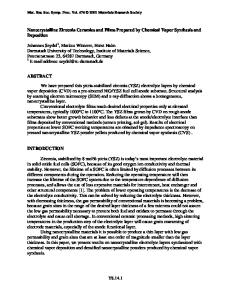Chemical Vapor Deposition of Titania/Silica and Zirconia Films
- PDF / 4,398,858 Bytes
- 10 Pages / 612 x 792 pts (letter) Page_size
- 15 Downloads / 368 Views
Chemical Vapor Deposition of Titania/Silica and Zirconia Films Wayne L. Gladfelter a, Ryan C. Smith a, David Burleson, Charles J. Taylor a, Jeffrey T. Robertsa, Stephen A. Campbell b, Noel Hoilien b, Mike Tiner c, Rama Hegde c and Christopher Hobbs c a
Departments of Chemistry and b Computer and Electrical Engineering, University of Minnesota, Minneapolis, MN 55455. c Motorola Advanced Products Research and Development Laboratory, Austin, TX 78721.
ABSTRACT Amorphous thin films of composition TixSi1-xO2 have been grown by low pressure chemical vapor deposition on silicon (100) substrates using Si(OEt)4 and either Ti(OiPr)4 or anhydrous Ti(NO3)4 as the sources of SiO2 and TiO2, respectively. The substrate temperature was varied between 300 and 535ºC, and the precursor flow rates ranged from 5 to 100 sccm. Under these conditions growth rates ranging from 0.6 to 90.0 nm/min were observed. Films were amorphous to X-rays as deposited and SEM micrographs showed smooth, featureless film surfaces. Cross-sectional TEM showed no compositional inhomogeneity. RBS revealed that x (from the formula TixSi1-xO2) was dependent upon the choice of TiO2 precursor. For films grown using TTIP-TEOS x could be varied by systematic variation of the flow of N2 through the precursor vessels or the deposition temperature. For the case of TN-TEOS x remained close to 0.5. The results suggested the existence of a specific chemical reaction between TN and TEOS prior to film deposition. The CVD of zirconium dioxide (ZrO2) films from zirconium tetra-tert-butoxide {Zr[OC(CH3)3]4} is also described. The films, which were deposited on Si(100), were characterized by scanning electron microscopy (SEM), transmission electron microscopy (TEM), ellipsometry, X-ray diffraction (XRD), and Rutherford backscattering spectroscopy (RBS). Deposition was studied between ~380 and 825 °C, and at precursor pressures between 4 × 10-5 and 1 × 10-4 Torr. The kinetics for steady-state growth were studied as functions of temperature and precursor pressure. Results were fit to a two-step kinetic model involving reversible precursor adsorption followed by irreversible decomposition to ZrO2.
INTRODUCTION As the thickness of the gate oxide in field effect transistors approaches 2 nm, direct tunneling will lead to unacceptable leakage currents making it necessary to replace the silicon dioxide layer with a material possessing a higher dielectric constant. An important consideration in integrating a new material is its microstructure. In particular, for the thin films necessary in microelectronics surface roughness and grain boundaries resulting from polycrystalline films can have an undesirable effect on properties such as the dielectric breakdown and leakage current. To minimize roughness and grain boundaries the high κ material can be made amorphous by combining it with a low κ, glass forming oxide such as SiO2. Titanium silicon oxide films have been produced by sol-gel,1,2 flame hydrolysis,3,4 and plasma enhanced CVD5,6 for optical applications and some reports of their e
Data Loading...










